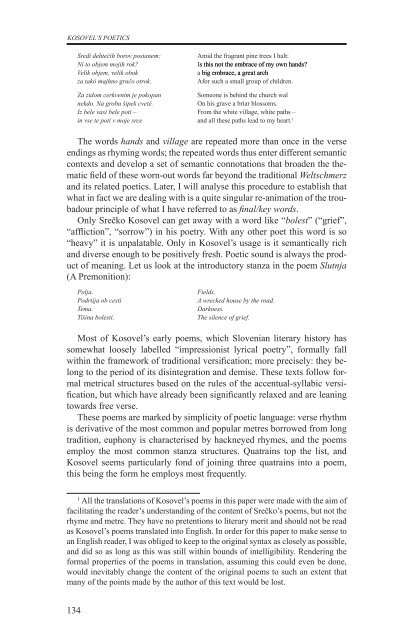razprave (pdf) - Društvo za primerjalno književnost - ZRC SAZU
razprave (pdf) - Društvo za primerjalno književnost - ZRC SAZU
razprave (pdf) - Društvo za primerjalno književnost - ZRC SAZU
- No tags were found...
Create successful ePaper yourself
Turn your PDF publications into a flip-book with our unique Google optimized e-Paper software.
KOSOVEL’s poeticsSredi dehtečih borov postanem:Ni to objem mojih rok?Velik objem, velik obok<strong>za</strong> takó majhno gručo otrok.Amid the fragrant pine trees I halt:Is this not the embrace of my own hands?a big embrace, a great archAfor such a small group of children.Za zidom cerkvenim je pokopanSomeone is behind the church walnekdo. Na grobu šipek cveté.On his grave a briar blossoms.Iz bele vasi bele poti – From the white village, white paths –in vse te poti v moje srce and all these paths lead to my heart. 1The words hands and village are repeated more than once in the verseendings as rhyming words; the repeated words thus enter different semanticcontexts and develop a set of semantic connotations that broaden the thematicfield of these worn-out words far beyond the traditional Weltschmer<strong>za</strong>nd its related poetics. Later, I will analyse this procedure to establish thatwhat in fact we are dealing with is a quite singular re-animation of the troubadourprinciple of what I have referred to as final/key words.Only Srečko Kosovel can get away with a word like “bolest” (“grief”,“affliction”, “sorrow”) in his poetry. With any other poet this word is so“heavy” it is unpalatable. Only in Kosovel’s usage is it semantically richand diverse enough to be positively fresh. Poetic sound is always the productof meaning. Let us look at the introductory stan<strong>za</strong> in the poem Slutnja(A Premonition):Polja.Podrtija ob cestiTema.Tišina bolesti.Fields.A wrecked house by the road.Darkness.The silence of grief.Most of Kosovel’s early poems, which Slovenian literary history hassomewhat loosely labelled “impressionist lyrical poetry”, formally fallwithin the framework of traditional versification; more precisely: they belongto the period of its disintegration and demise. These texts follow formalmetrical structures based on the rules of the accentual-syllabic versification,but which have already been significantly relaxed and are leaningtowards free verse.These poems are marked by simplicity of poetic language: verse rhythmis derivative of the most common and popular metres borrowed from longtradition, euphony is characterised by hackneyed rhymes, and the poemsemploy the most common stan<strong>za</strong> structures. Quatrains top the list, andKosovel seems particularly fond of joining three quatrains into a poem,this being the form he employs most frequently.1All the translations of Kosovel’s poems in this paper were made with the aim offacilitating the reader’s understanding of the content of Srečko’s poems, but not therhyme and metre. They have no pretentions to literary merit and should not be readas Kosovel’s poems translated into English. In order for this paper to make sense toan English reader, I was obliged to keep to the original syntax as closely as possible,and did so as long as this was still within bounds of intelligibility. Rendering theformal properties of the poems in translation, assuming this could even be done,would inevitably change the content of the original poems to such an extent thatmany of the points made by the author of this text would be lost.134
















